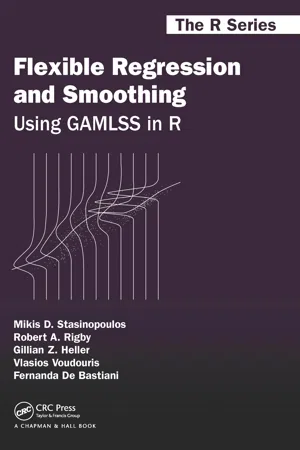
Flexible Regression and Smoothing
Using GAMLSS in R
- 549 pages
- English
- ePUB (mobile friendly)
- Available on iOS & Android
Flexible Regression and Smoothing
Using GAMLSS in R
About this book
This book is about learning from data using the Generalized Additive Models for Location, Scale and Shape (GAMLSS). GAMLSS extends the Generalized Linear Models (GLMs) and Generalized Additive Models (GAMs) to accommodate large complex datasets, which are increasingly prevalent.
In particular, the GAMLSS statistical framework enables flexible regression and smoothing models to be fitted to the data. The GAMLSS model assumes that the response variable has any parametric (continuous, discrete or mixed) distribution which might be heavy- or light-tailed, and positively or negatively skewed. In addition, all the parameters of the distribution (location, scale, shape) can be modelled as linear or smooth functions of explanatory variables.
Key Features:
-
- Provides a broad overview of flexible regression and smoothing techniques to learn from data whilst also focusing on the practical application of methodology using GAMLSS software in R.
-
- Includes a comprehensive collection of real data examples, which reflect the range of problems addressed by GAMLSS models and provide a practical illustration of the process of using flexible GAMLSS models for statistical learning.
-
- R code integrated into the text for ease of understanding and replication.
-
- Supplemented by a website with code, data and extra materials.
This book aims to help readers understand how to learn from data encountered in many fields. It will be useful for practitioners and researchers who wish to understand and use the GAMLSS models to learn from data and also for students who wish to learn GAMLSS through practical examples.
Frequently asked questions
- Essential is ideal for learners and professionals who enjoy exploring a wide range of subjects. Access the Essential Library with 800,000+ trusted titles and best-sellers across business, personal growth, and the humanities. Includes unlimited reading time and Standard Read Aloud voice.
- Complete: Perfect for advanced learners and researchers needing full, unrestricted access. Unlock 1.4M+ books across hundreds of subjects, including academic and specialized titles. The Complete Plan also includes advanced features like Premium Read Aloud and Research Assistant.
Please note we cannot support devices running on iOS 13 and Android 7 or earlier. Learn more about using the app.
Information
Part IV
Model terms
8
Linear parametric additive terms
8.1 Introduction to linear and additive terms
Table of contents
- Cover
- Half Title
- Title Page
- Copyright Page
- Dedication
- Table of Contents
- Preface
- I Introduction to models and packages
- II Algorithms, functions and inference
- III Distributions
- IV Model terms
- V Model selection and diagnostics
- VI Applications
- Bibliography
- Index